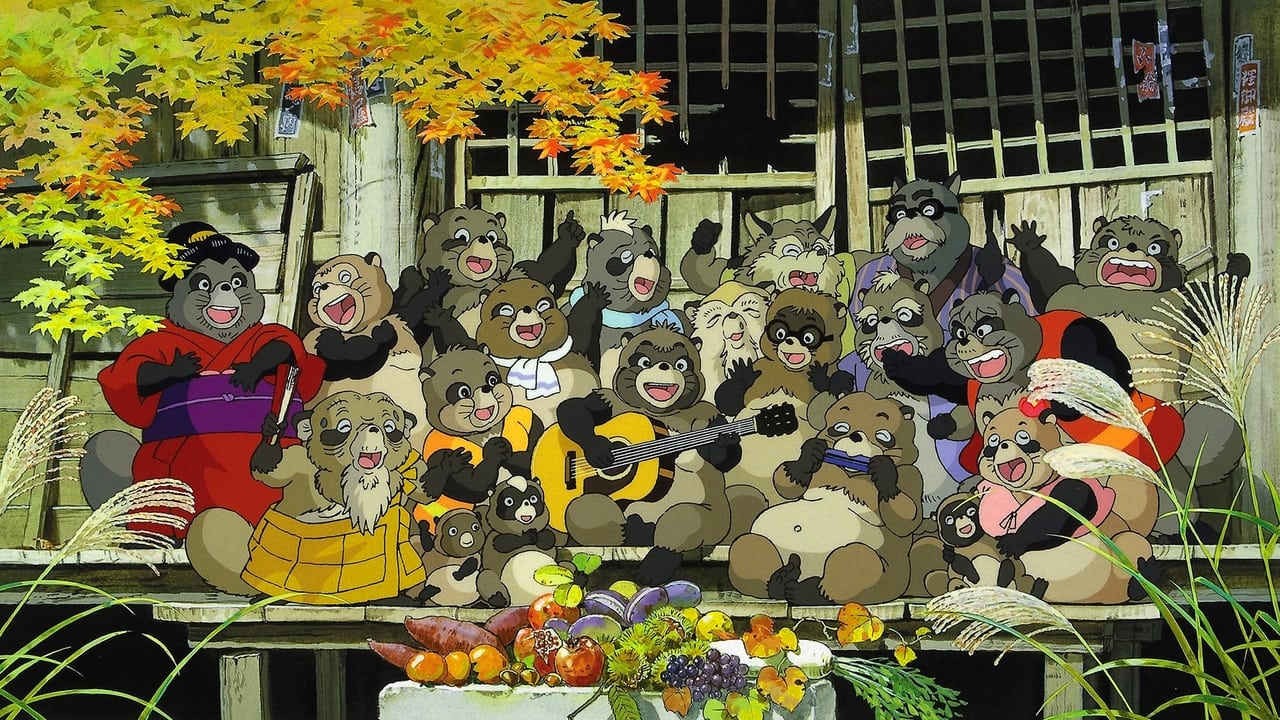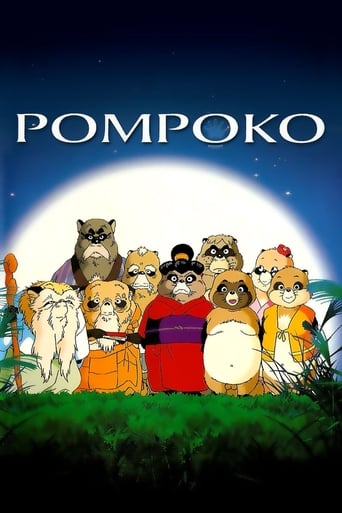

Excellent, a Must See
... View MoreIt's fun, it's light, [but] it has a hard time when its tries to get heavy.
... View MoreGreat movie. Not sure what people expected but I found it highly entertaining.
... View More.Like the great film, it's made with a great deal of visible affection both in front of and behind the camera.
... View MoreThis is perhaps the only film by Ghibli that I really found it to be BAD. I mean, it is truly BAD. I watched it in the same day as Only Yesterday, and boy, the contrast in quality was amazing. Takahata really dropped the ball on this one: his previous film is easily the best film of 1991, for me at least, and this one is BELOW average. I mean, Ghibli has managed it: they made a film that is below the Hollywood average quality for their canned products.Why this film is so bad? Because nothing works: the characters don't fell like "people", they are cartoon characters truly. This film is perhaps the least artistically accomplished film that Ghibli ever made and one of the least intelligent ones as well. It feels much like an American cartoon, and yes, those suck. Not recommended, really: a genius like Takahata made this poppy!
... View MoreWhen I was about to watch this film, my daughter (who is an expert on mythology) exclaimed "That film is about the tanuki...you DO know what the tanuki are, don't you Dad?!". Well, I didn't have the foggiest idea and was surprised when she told me about these mythical raccoon/dog-like creatures. It seems that they are renowned for their enormous testicles--yes, testicles. She then showed me some Japanese artwork--and the size was massive to say the least! Now the Studiog Gibli versions were NOT this well endowed--but western audiences still would most likely be shocked by cartoon animals with testicles--even of the non-gargantuan variety. I am not telling you to avoid the film--just letting you know what to expect. This could explain why this film did not get widespread release here in the States--though the preachy plot might also have something to do with it."Pom Poko" is a cartoon with a very strong message about conservation...with testicles. Now if you hate business and wish we had enforced zero population growth, this film is for you. If you don't, is it still worth seeing or is the message too preachy and anti-business? Keep reading to see for yourself.It seems that the tanuki are concerned because they have finally realized that fighting among themselves is stupid, as humans are destroying the environment and building everywhere. They take a vote and decide that they will stop this. But, considering these creatures are rather lazy and have difficulty concentrating, this is a tall order indeed. When they finally stop pretending to be asleep or sitting around watching pro wrestling and cooking shows on TV, they get down to preparing for their attack. They learn the ancient are of transformation--to change appearance to disguise themselves as inanimate and animate objects. This part of the film is pretty funny, as apparently the raccoons aren't all that good at it and this led to some funny scenes--as well as learning that energy drinks were developed specifically for raccoons disguised as humans! What followed next, however, was NOT funny. In a series of attacks that looked as if the tanuki were members of Earth First, they sabotaged trucks, cars and equipment. They don't show people dying, but the news man in the movie says people were killed. At this point, I knew this was NOT a film for kids!! It's also pretty creepy when the elder tells the tanuki that they should not celebrate the deaths of humans--at which point they all started laughing hysterically and had a big party. What the crap?! Even Captain Planet wouldn't do that! Fortunately, the tanuki decided to try to trick the humans instead of killing them--and this part of the film was rather clever and I wish more of the film had been filled with these clever pranks.What follows is the inevitable and depressing slow destruction of the land and the tanuki's plans seem to fall apart. Instead of stopping the construction, they mostly make love and have fun until eventually they get their act together--that's when the Transformations Masters arrive to teach the tanuki how to properly scare the humans to make them think the land is haunted. Once again, this sort of thing is pretty funny to watch--much better than their previous "kill all humans" philosophy. But, one of the Masters dies in the process...what a downer. And, surprisingly, the humans LIKED the hauntings and thought they were cool. So, once again, the tanuki are dispirited and don't know what to do next. So how do they survive...or do they? Tune in to see if you are interested.I did not like this film very much--despite the animation being nice and there being a lot of funny moments. The message that mankind stinks and that nature is god is so very, very preachy. Those on the far left will probably love it--those on the far right will hate it. And those in the middle will wonder why the film is so unlike "My Neighbor Totoro"--and why they can't really show it to kids.By the way, some of the American voices used by Disney were a bit surreal. A couple were from voice actors from "Futurama" and hearing Morbo's voice coming out of a raccoon was odd...very odd.
... View MoreThe high production values expected of Studio Ghibli are well to the fore, and so are the studio's well-established ecological concerns and emphasis on community. Pom Poko was supposedly inspired by the construction of a new suburb in the Tama Hills, west of Tokyo. The tanuki act like a collective of eco-protesters, with the same conflicts, wasted efforts and internal squabbles. Director Isao Takahata has a broad humorous streak, demonstrated by an extended visual gag about tanuki testicles. There are many folk stories about the ludicrous uses to which tanuki put their genitals, but most directors avoid including them in family films. He also laces the story with less explicit - and less explicitly Japanese - jokes, and as a result this is a funny, charming, and very entertaining film.
... View MoreMost anime fans remember Isao Takahata best for his wonderful tearjerker, "Grave of the Fireflies", will find interesting this title as well. This lavishly animated tale about raccoons battling for their homeland isn't so dramatic as "Grave of the Fireflies" but is an interesting amalgam of humor, drama, and action delivered instead. At times, the viewer gets treated to scenes which recall the tragic elements , but even though the tone of the movie is somber, a handful of lighthearted moments elevate the overall production out of depression. As this is a Studio Ghibli film, production values are spectacular. Backgrounds are painted with a tasteful mixture of simplicity and art, and the raccoons are as cuddle-some as you would expect. (If you're scratching your head while reading this, don't be alarmed--according to Japanese folklore, raccoons have the power to transform into anything--including human beings) The actual animation is as colorful and imaginative as you might expect from a Ghibli movie(and there is one scene where we are treated to cameo appearances by Porco Rosso, Kiki, and Totoro.) While Pom Poko has a story to tell and a meaningful message for one to think about, its character and plot aspects may come across as a bit off-putting to viewers expecting a typical animated feature. Indeed, while some raccoons identify themselves with distinguishable names and/or personalities (for example, Gonta is a burly, rough-and-ready raccoon who is always looking for a fight, while Oroku is the "wise woman" of the tribe), the story offers little in the way of character development. In fact, most of the action in the story is narrated (by Maurice LaMarche in English, Kokondei Shinchou in Japanese), which elevates the overall effect of the movie to that of a semi-documentary. For the most part, this approach works to a very interesting degree and is a refreshing change of pace. However, there were some scenes in the movie where I wished the narration could have been reduced a little bit, as it sometimes gets in the way of appreciating the beauty of the visuals on screen. Unfortunately, most of the attention that this movie received were some silly controversies about the fact that the movie shows the testicles of the male raccoons, but that was a minor detail if you compare with the charm and the originality of the story. Even when it is not perfect (Some consider this movie a inferior work of Ghibli )this movie was funny enough for me, and is one of the my favorite animes.
... View More